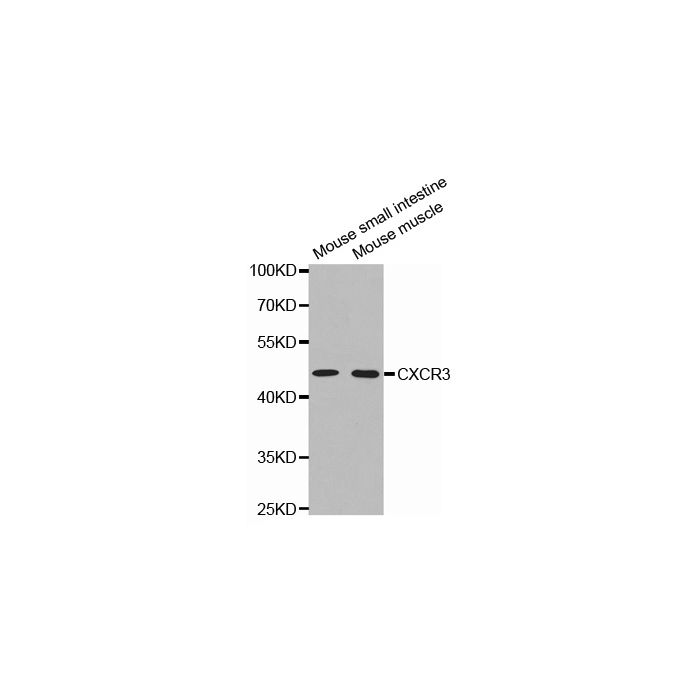CD183 (CXCR-3) polyclonal, anti-human, mouse
€388.00
In stock
SKU
BS6993
Background:
The CXC or a chemokine family is characterized by a pair of cysteine residues separated by a single amino acid and primarily functions as chemo-attractants for neutrophils. The CXC family includes IL-8, NAP-2, MSGA and stromal cell derived factor-1 or SDF-1. SDF-1 was originally described as a pre-B cell stimulatory factor, but has now been shown to function as a potent chemoattractant for T cells and monocytes but not neutrophils. Receptors for the CXC family are G protein-coupled, seven pass transmembrane domain proteins which include IL-8RA, IL-8RB, CXCR-3 and fusin (variously referred to as LESTR or CXCR-4). CXCR-3, also known as IP-10/Mig receptor, mediates Ca++ mobilization and chemotaxis in response to the CXC chemo-kines IP-10 and Mig. CXCR-3 is highly expressed in IL-2-activated T lymphocytes, but not in resting T lymphocytes, B lymphocytes, monocytes or granulocytes.
Alternative Name:
C-X-C chemokine receptor type 3, CXC-R3, CXCR-3, CKR-L2, G protein-coupled receptor 9, Interferon-inducible protein 10 receptor, IP-10 receptor, CD183, GPR9, CXCR3
Application Dilution: WB: 1:500 - 1:2000, IHC: 1:50 - 1:100
Specificity: CXCR-3 polyclonal antibody detects endogenous levels of CXCR-3 protein.
Immunogen:
Recombinant full length Human CXCR-3.
MW: ~ 40 kDa
Swis Prot.: P49682
Purification & Purity:
The antibody was affinity-purified from rabbit antiserum by affinity-chromatography using epitope-specific immunogen and the purity is > 95% (by SDS-PAGE).
Format:
1mg/ml in PBS with 0.1% Sodium Azide, 50% Glycerol.
Storage:
Store at 4°C short term. Aliquot and store at -20°C long term. Avoid freeze-thaw cycles.
For research use only, not for use in diagnostic procedure.
The CXC or a chemokine family is characterized by a pair of cysteine residues separated by a single amino acid and primarily functions as chemo-attractants for neutrophils. The CXC family includes IL-8, NAP-2, MSGA and stromal cell derived factor-1 or SDF-1. SDF-1 was originally described as a pre-B cell stimulatory factor, but has now been shown to function as a potent chemoattractant for T cells and monocytes but not neutrophils. Receptors for the CXC family are G protein-coupled, seven pass transmembrane domain proteins which include IL-8RA, IL-8RB, CXCR-3 and fusin (variously referred to as LESTR or CXCR-4). CXCR-3, also known as IP-10/Mig receptor, mediates Ca++ mobilization and chemotaxis in response to the CXC chemo-kines IP-10 and Mig. CXCR-3 is highly expressed in IL-2-activated T lymphocytes, but not in resting T lymphocytes, B lymphocytes, monocytes or granulocytes.
Alternative Name:
C-X-C chemokine receptor type 3, CXC-R3, CXCR-3, CKR-L2, G protein-coupled receptor 9, Interferon-inducible protein 10 receptor, IP-10 receptor, CD183, GPR9, CXCR3
Application Dilution: WB: 1:500 - 1:2000, IHC: 1:50 - 1:100
Specificity: CXCR-3 polyclonal antibody detects endogenous levels of CXCR-3 protein.
Immunogen:
Recombinant full length Human CXCR-3.
MW: ~ 40 kDa
Swis Prot.: P49682
Purification & Purity:
The antibody was affinity-purified from rabbit antiserum by affinity-chromatography using epitope-specific immunogen and the purity is > 95% (by SDS-PAGE).
Format:
1mg/ml in PBS with 0.1% Sodium Azide, 50% Glycerol.
Storage:
Store at 4°C short term. Aliquot and store at -20°C long term. Avoid freeze-thaw cycles.
For research use only, not for use in diagnostic procedure.
| Is Featured? | No |
|---|
Write Your Own Review

